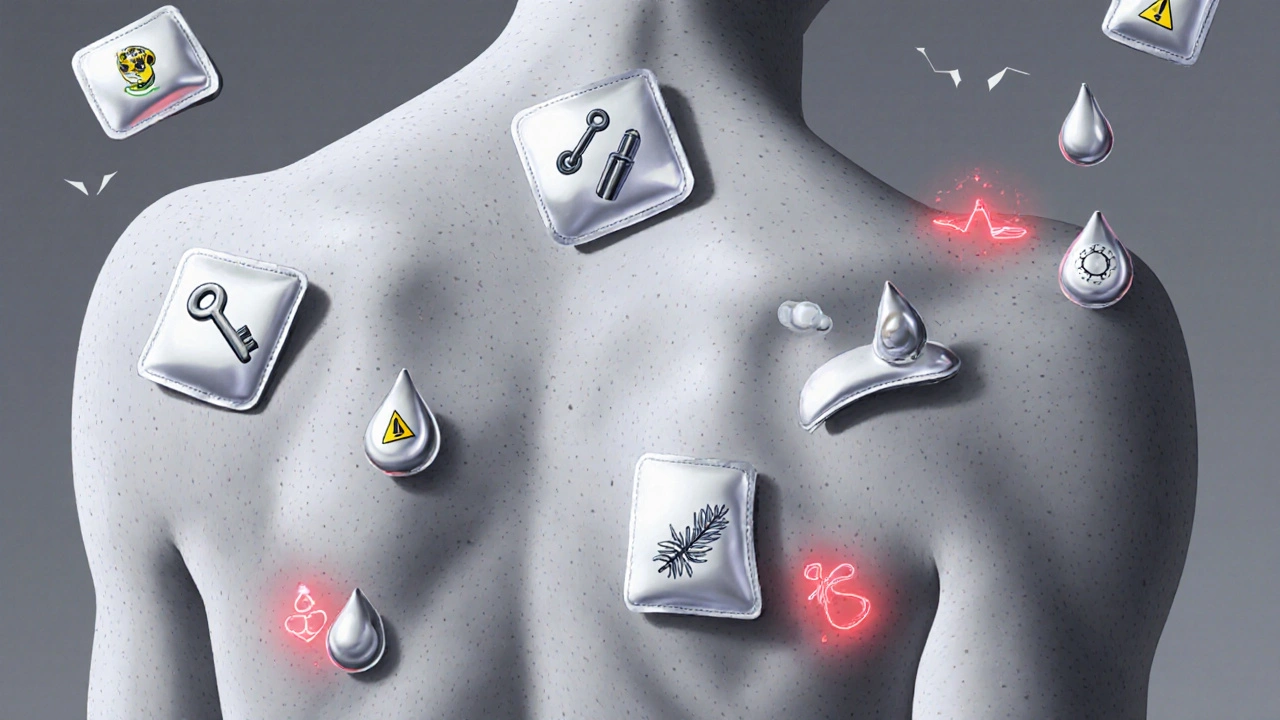If your skin keeps reacting-itching, red, flaking, or blistering-without any clear reason, you’re not alone. Many people blame soap, laundry detergent, or even stress. But sometimes, the real culprit is something you touch every day: a hidden contact allergen. These aren’t just random irritants. They’re specific chemicals that trigger a delayed immune response, turning your skin into a battlefield. And the only way to find out what’s causing it? Patch testing.
What Is Patch Testing, Really?
Patch testing isn’t like a skin prick test for pollen or peanuts. That kind of test gives you a reaction in minutes. Patch testing is slower. It’s designed to catch delayed reactions-those that show up 48 to 96 hours later. That’s because it’s not an IgE-mediated allergy. It’s a T-cell response. Your immune system doesn’t jump into action right away. It takes time to recognize the chemical as a threat.
The process is simple but strict. Small amounts of common allergens are placed in tiny chambers-usually aluminum discs called Finn chambers-and taped to your back. Between 30 and 100 different substances can be tested at once. These aren’t random samples. They’re standardized, high-purity chemicals mixed with petrolatum, calibrated to mimic real-world exposure. Think nickel in jewelry, fragrances in shampoo, or preservatives in moisturizers.
You wear these patches for exactly 48 hours. No showering. No sweating. No swimming. Even a little moisture can wash away the allergens or cause false results. After two days, you return to have the patches removed. The skin is marked so the doctor knows exactly where each allergen was placed. Then you wait another 48 hours for the final reading. That’s three visits in about a week: Monday, Wednesday, Friday.
What Do the Results Mean?
A positive patch test doesn’t mean you’re allergic to everything on your back. It means one-or maybe more-of those substances triggered a reaction. The reaction looks like a raised, red, sometimes blistering patch right where the patch was. The intensity tells the doctor how strong your sensitivity is.
But here’s the catch: not everyone gets a positive result. That doesn’t mean you’re fine. It might mean your trigger isn’t in the standard panel. Or maybe your rash isn’t allergic at all-it could be irritant contact dermatitis, which looks similar but isn’t caused by your immune system. That’s why patch testing is called the gold standard. It’s not perfect, but it’s the only test that reliably finds the hidden culprits behind stubborn rashes.
Standard panels cover about 70% of cases. But if you’re a hairdresser, a nurse, a mechanic, or work with electronics, your risk profile is different. That’s where expanded testing comes in. Florists might be tested for chrysanthemum allergens. Dental workers get checked for mercury or acrylates. Plumbers? Chromium and epoxy resins. These specialty panels bump the detection rate up to 80%.
Common Contact Allergens You Might Not Know About
Most people think of nickel in earrings or belts. But the real offenders are often in things you use daily:
- Nickel: Found in jewelry, zippers, phone cases, even some kitchen utensils. It’s the #1 allergen worldwide.
- Formaldehyde: Used in nail polish, shampoos, cosmetics, and even some fabrics. Often hidden under names like ‘quaternium-15’ or ‘DMDM hydantoin’.
- Paraphenylenediamine (PPD): The main ingredient in black hair dye. Even ‘natural’ dyes can contain it.
- Neomycin: A common antibiotic in over-the-counter creams. Ironically, it can cause the very rash it’s meant to treat.
- Chromates: Found in cement, leather, paints, and some anti-rust products. Construction workers and mechanics are at high risk.
- Fragrances: Both synthetic and natural. Lavender, tea tree, citrus oils-they can all trigger reactions. There are over 50 fragrance mixtures tested in standard panels.
- Coconut diethanolamide: A foaming agent in soaps and shampoos. Often listed as ‘CDEA’.
- Thimerosal: A preservative in some eye drops and vaccines. Less common now, but still found in some products.
And here’s something most people don’t realize: your favorite ‘hypoallergenic’ lotion might still contain a hidden allergen. The term ‘hypoallergenic’ isn’t regulated. It doesn’t mean ‘safe for everyone.’ It just means fewer additives were used. Still, it might have a fragrance or preservative that triggers you.

Patch Testing vs. Irritant Contact Dermatitis
Not every red, itchy patch is an allergy. In fact, most are not. Irritant contact dermatitis is far more common. It happens when a substance-like bleach, detergent, or even repeated handwashing-directly damages your skin barrier. No immune system involved. Just physical wear and tear.
The difference? Irritant reactions usually appear quickly, within minutes or hours. They’re often painful, not itchy. They show up where the substance touched the skin, and they don’t spread beyond that area. Allergic reactions take days. They can spread slightly beyond the patch site. They itch intensely. And they can flare up again even after months of avoiding the trigger.
Patch testing only finds allergic reactions. If your rash is irritant, the test will come back negative. That’s why your doctor needs to know your full history: what you do for work, what products you use, how often you wash your hands, whether you wear gloves.
What Happens After a Positive Result?
Getting a positive patch test isn’t the end-it’s the beginning of real relief. Now you know what to avoid. But avoidance isn’t always easy. Nickel is everywhere. Fragrances are in 90% of personal care products. You’ll need to read labels like a detective.
Your dermatologist will give you a list of safe products. Many companies now label for common allergens. Look for ‘nickel-free,’ ‘fragrance-free,’ or ‘preservative-free.’ But don’t trust the word ‘natural.’ Natural doesn’t mean safe. Tea tree oil can trigger a reaction just like synthetic fragrance.
For active rashes, topical steroids are the first-line treatment. For severe cases, a short course of oral steroids might be needed. Antihistamines won’t fix the rash-they don’t touch the type IV reaction-but they can help with the itching so you can sleep.
Some people try ‘repeat open application testing’ at home. That’s when you apply a suspect product-like your shampoo-to a small patch of skin on your forearm twice a day for 5-10 days. If no reaction shows up, it’s likely not the culprit. If it does? You’ve found your trigger without a clinic visit.

Can You Outgrow a Contact Allergen?
Unlike food allergies, contact allergies rarely go away. Once your immune system recognizes nickel or formaldehyde as a threat, it remembers. Avoidance is lifelong. But here’s the good news: once you know what to avoid, your skin usually clears up completely. Many patients go from constant rashes to being completely symptom-free.
The key is consistency. One slip-up-a new pair of jeans with a nickel button, a new hand cream-can set you back weeks. That’s why education is part of the treatment. Your dermatologist doesn’t just hand you a list. They teach you how to decode ingredient labels, how to shop for safe products, how to talk to your employer about workplace exposure.
What If Patch Testing Doesn’t Find Anything?
If your test comes back negative and your rash persists, don’t give up. There are still options. You might need a biopsy to rule out other skin conditions like psoriasis or eczema. Or you might have photocontact dermatitis-where sunlight activates a chemical on your skin. Or maybe your trigger isn’t even in the standard panel yet. New allergens pop up all the time as product formulas change.
Some dermatologists now offer custom panels based on your job, hobbies, or products you use. If you’re a gardener, they might test for poison ivy analogs. If you’re into tattoos, they might check for tattoo ink ingredients.
And sometimes, the answer isn’t an allergen at all. Stress, humidity, hormonal shifts, even tight clothing can mimic contact dermatitis. But patch testing still gives you a clear starting point. It rules out the most common causes so you can focus on the rest.
Why This Matters More Than You Think
Contact dermatitis isn’t just a nuisance. It’s a hidden public health issue. Millions of people suffer from it. Many work in jobs where exposure is unavoidable. Nurses, cleaners, hairdressers, mechanics-they’re at higher risk. And without proper diagnosis, they’re stuck in a cycle of rashes, creams, and frustration.
Patch testing changes that. It turns guesswork into certainty. It turns chronic skin problems into manageable conditions. It gives people back control over their bodies. And it’s accessible. Most insurance plans cover it. No needles. No blood draws. Just a few patches on your back.
If you’ve been dealing with unexplained skin issues for months-if you’ve tried every cream, changed your detergent, switched to ‘gentle’ products-and nothing helps-it’s time to ask your dermatologist about patch testing. It’s not magic. But it’s the most reliable tool we have to find the invisible trigger hiding in plain sight.


Comments (13)
Erika Hunt
Okay, so I’ve had this weird rash on my wrists for like, two years now? And I thought it was stress, or maybe my new phone case? Turns out, it was nickel in the damn zipper on my jeans. I didn’t even know zippers had nickel! Patch testing was a game-changer. I went from daily itching to zero symptoms in three weeks. Just… avoid the metal. Simple, right? But nobody tells you this stuff. I’m telling you now. If your skin’s acting up, get tested. Don’t just slap on more cream.
Srikanth BH
This is such a helpful breakdown! I’ve been working as a nurse for 12 years and my hands are always cracked and red-thought it was just from washing them too much. Turns out, it was neomycin in the antibiotic ointment I used every shift. I stopped using it and switched to plain petrolatum… and my skin healed. Thank you for explaining how patch testing works. So many people suffer in silence. This deserves more visibility!
Jennifer Griffith
i got patch tested last year and it was so boring like i had to sit there for 2 days with duct tape on my back and then my dr was like oh u r allergic to lavender?? like??? i dont even use lavender soap??
Roscoe Howard
It is imperative to underscore that the American healthcare system remains uniquely equipped to deliver such precise diagnostic modalities as patch testing. In nations with inferior infrastructure, patients are left to endure chronic dermatological distress without recourse. The standardization of allergen panels in the United States-under FDA and ASTM guidelines-is unmatched globally. One must question the ethics of exporting substandard diagnostic protocols to developing regions.
Kimberley Chronicle
From a dermatological immunology standpoint, the T-cell-mediated Type IV hypersensitivity is elegantly captured here. The delayed kinetics (48–96h) are textbook, and the use of Finn chambers ensures controlled antigen delivery. What’s under-discussed is the role of epidermal Langerhans cell antigen presentation in priming the response. Also-fragrance mix I and II are still the most common positives in our clinic. I’d love to see expanded panels for occupational cohorts integrated into routine testing protocols.
Lisa Odence
Just got my results back. Positive for formaldehyde releasers (DMDM hydantoin) AND coconut diethanolamide. 🤯 I’ve been using ‘gentle’ shampoos for years. Turns out, ‘gentle’ is a marketing lie. Also, my ‘natural’ face oil? Tea tree oil. 😭 I’m now reading every ingredient like it’s a court document. #PatchTestLife #HypoallergenicIsAMyth 🧴🚫
Patricia McElhinney
It’s unacceptable that so many people still don’t understand that ‘natural’ doesn’t mean safe. Tea tree oil is a known sensitizer. Lavender? Same. If you’re using essential oils on your skin, you’re playing Russian roulette with your immune system. And if your dermatologist isn’t testing for fragrance mixes, they’re not doing their job. I’ve seen too many patients waste years on useless creams. This is basic dermatology. Why is this even a conversation?
Dolapo Eniola
bro why are we even doing this? in nigeria we just use shea butter and pray. patch testing? that’s a rich people thing. we don’t have labs for that. my cousin had a rash for 3 years and his mom rubbed pepper on it. now he’s fine. stop overcomplicating life. 🤷♂️🔥
Agastya Shukla
Interesting that you mention expanded panels. In our occupational dermatology unit, we’ve added acrylates for nail technicians and epoxy resins for engineers. The sensitivity rates jump from 68% to 84% with targeted panels. The challenge? Insurance coverage. Most plans still only cover the standard 70-panel. We’re lobbying for reimbursement reform. This isn’t luxury medicine-it’s preventive occupational health.
Pallab Dasgupta
YOOOO I just found out I’m allergic to my own shampoo. Like, the one I’ve used since college. I thought my scalp was just dry. Turns out? PPD in the ‘natural henna’ dye I used once. I cried. I laughed. I threw out 17 products. Now I only use Cetaphil and a $3 plain soap from the dollar store. My skin hasn’t been this calm since 2018. If you’re reading this and your skin hates you? DO THE TEST. Your future self will thank you. 🙏❤️
giselle kate
It’s not about the allergens. It’s about the systemic failure of modern society to produce safe products. We’ve been poisoned by corporate greed disguised as ‘innovation.’ Fragrances aren’t just chemicals-they’re psychological weapons. Nickel? A colonial relic of cheap manufacturing. This isn’t dermatology. It’s a revolution. Wake up. Your skin is screaming. Are you listening?
Leisha Haynes
so you mean to tell me my expensive $80 ‘clean’ face serum has formaldehyde in it? and i thought i was being so good??? 🤡 guess i’ll be going back to Vaseline and regretting every purchase since 2020
Shivam Goel
Let’s be precise: the sensitivity of patch testing for nickel is approximately 82–91% in populations with suspected allergic contact dermatitis, with specificity exceeding 95%. However, false negatives occur in 12–18% of cases due to inadequate antigen concentration, premature patch removal, or concurrent topical steroid use. Furthermore, the clinical correlation between patch test positivity and symptom recurrence upon re-exposure remains the true gold standard-not the test itself. Always correlate with history. Always. And yes, ‘hypoallergenic’ is a legally unregulated term in the U.S.-FDA has no definition for it. This is critical.